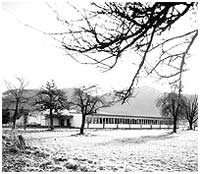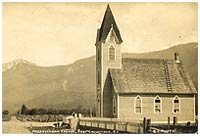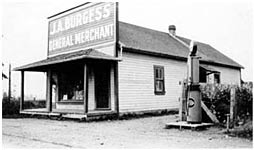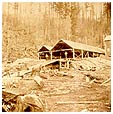
"John Parker's [an early resident] place had more low lying land than we had. This, in Spring, was very boggy and often the horses were obliged to wear clogs on their feet to do the work. We, on the high land, thought poorly of the Big Prairie. It was very rich soil but badly needed draining. So much water came from the hills and found a resting place on the flat!" (Hickman, Mary Ethel, The Early Days, The Circle Ranch Press, May 1983. p. 57).
She further wrote that; "On the upper stretch of the district in the eastern section, clearing was difficult as the trees attained a great height and size. When the trees were felled, huge stumps remained, often 10-12 feet in diameter at the base. Sometimes they were larger. The first operation after the trees were down and limbed and the brush piled, was burning. This was a fearsome site as the fire roared over the dry slashing, but a good burn was most important. After the first fire or burning was completed, the small sticks were gathered together, burned again and then the land was ready for seeding." (Hickman, Mary, Early History of East Chilliwack).
Settlement followed an easterly direction. A network of corduroy roads began to criss-cross the area. Banford Road (1879), Upper Prairie Road (1886) and Gibson Road (1896) testify to this pattern.
By 1890 the population of the area was large enough that a school was built and a school remains on the same site.
After 1900 all of the land in East Chilliwack was alienated and the tasks of draining and clearing the land proceeded with earnestness. Many of the major drainage projects that characterize the area date from the post-1900 period. The big ditch, along Upper Prairies Road and the interception ditch were constructed in the first part of the century.
Several churches were once located in East Chilliwack. A Catholic Church on Upper Prairie Road operated for a few years in the 1890s but was possibly moved into Chilliwack at a later date. A Presbyterian Church and the Church of Jesus Christ of Latter Day Saints were also located in East Chilliwack. Neither remains.
In the mid-1940s, Mennonite families settled in the area and a church was built on Chilliwack Central Road. This church now serves the congregation of the Canadian Reformed Church.
The East Chilliwack Women's Institute Hall remains as one of the few buildings connected to the pre-1940 agricultural life of the community. Ray and Alvin Aitken built the simple frame structure, across from the East Chilliwack School. It was the first Women's Institute hall in British Columbia to be owned and built by a Women's Institute.
East Chilliwack remains as one the most important agricultural sections of Chilliwack.

The East Chilliwack Elementary School as it appeared during the winter of 1961. P3860.

Picture postcard view of the Presbyterian Church in East Chilliwack, Feb. 1910. P3805.


The J.A. Burgess General Merchant store, located at the corner of Chilliwack Central and Upper Prairie, East Chilliwack, 1928. P1998 38 11.
Down Country Roads / AM 616.